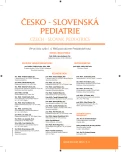Children´s involuntary exposure in smoking environment is even more dangerous than it has been expected
Authors:
D. Hrubá; V. Šikolová; A. Peřina
Authors‘ workplace:
Ústav preventivního lékařství LF MU, Brno
přednostka prof. MUDr. Bc. Z. Derflerová Brázdová, DrSc.
Published in:
Čes-slov Pediat 2014; 69 (4): 250-257.
Category:
Review
Overview
For decades, health professionals have been describing the danger of second-hand smoke and many countries have created the legislative norms protecting no-smokers against their involuntary exposure to passive smoking. Now, a growing number of scientists are interested in the “third-hand smoke” (THS), residues of tobacco smoke that remain in the indoor air and surfaces for hours, weeks, months, when cigarettes are extinguished. The sources of chemicals involved into the THS are the components emitted from the burning tobacco (mainly nicotine), but also obvious parts of indoor air (ozone, nitrous acid, nitrogen oxides). These substances can produce new dangerous chemicals, such as tobacco-specific nitrosamines, volatile organic compounds and others, by their inter- reactions. Although the toxic, mutagenic and carcinogenic effects of THS are under investigation, the increasing public interest about the third-hand smoke could change attitudes to smoking and better protect non-smokers, especially children.
Key words:
second-hand smoke, smoke aging, third-hand smoke, children exposure, prevention
Sources
1. Samet JM, Wang SS. Environmental tobacco smoke. In: Lippmann M (ed). Environmental Toxicants: Human exposures and their health effects. New York: Van Nostrand Reinhold Company, Inc., 2000: 319–375.
2. US Department of Health and Human Services (USDHHS). The health concequences of involuntary smoking. A report of the Surgeon General. DHHS Publications No. (CDC)87-8398. Washington DC: US Government Printing Office, 1986.
3. International Agency for Research on Cancer. IARC Monographs on the Evaluation of Carcinogenic Risks to Humans: Smokeless Tobacco and Some Tobacco-specific N-Nitrosamines. France, Lyon: 2007: 89.
4. U.S. Surgeon General Report. Office on Smoking and Health. The health consequences of involuntary exposure to tobacco smoke. A Report of the Surgeon General. Atlanta: Centers for Disease Control and Prevention, 2006. Dostupné z http://www.surgeongeneral.gov/library/reports/secondhandsmoke/index.html.
5. Rabinoff M. Pharmacological and chemical effects of cigarette additives. Am J Publ Health 2007; 97 (11): 1981–1991.
6. Schick SF, Glantz S. Concentrations of the carcinogen NNK in sidestream cigarette smoke increase after release into indoor air: Results from unpublished Tobacco Industry Research. Cancer Epidemiol Biomarkers Prev 2007; 16: 1547–1553.
7. Sleiman M, Gundel LA, Pankow JP, et al. Formation of carcinogens indoors by surface-mediated reactions of nicotine with nitrous acid, leading to potential third-hand smoke hazards. Proc Natl Acad Sci USA 2010; 107: 6576–6581.
8. Warren GW, Singh AK. Nicotine and lung cancer. J Carcinog 2013; 12, dostupné na http://www.ncbi.nlm.nih.gov/pmc/articles/PMC3622363.
9. Schick SF, Farraro KF, Perrino Ch, et al. Thirdhand cigarette smoke in an experimental chamber: evidence of surface deposition of nicotine, nitrosamines and polycyclic aromatic hydrocarbons and de novo formation of NNK. Tob Control 2013 May 28; [Epub ahead of print]. doi: 10.1136tobaccocontrol-2012-050915.
10. Winickoff JP, Friebely J, Tanski SE, et al. Beliefs about the health effects of „thirhand“ smoke and home smoking bans. Pediatrics 2009; 123: e74–79.
11. Schick SF, Farraro KF, Perrino Ch, et al. Thirdhand cigarette smoke in an experimental chamber: evidence of surface deposition of nicotine, nitrosamines and polycyclic aromatic hydrocarbons and de novo formation of NNK. Tob Control 2013 May 28; [Epub ahead of print]. doi: 10.1136tobaccocontrol-2012-050915.
12. Singer BC, Coleman BK, Destaillats H. et al. Indoor secondary pollutants from cleaning products and air freshener use in the presence of ozone. Atmos Environ 2006; 40: 6696–6710.
13. Matt GR, Quintana PJ, Zakarian JM, et al. When smokers move out and non-smokers move in: residential thirhand smoke pollution and exposure. Tob Control 2011; 20 (1): e1.
14. Fortmann AL, Romero RA, Sklar M, et al. Residual tobacco smoke in used cars: futile efforts and persistent pollutants. Nicotine Tob Res 2010; 12: 1029–1036.
15. Wilson KM, Klein JD, Blumkin AK, et al. Tobacco-smoke exposure in children who live in multiunit housing. Pediatrics 2011; 127: 85–92.
16. Thomas JL, Hecht SS, Luo X, et al. Thirdhand tobacco smoke: A tobacco-specific lung carcinogen on surfaces in smokers´ homes. Nicotine Tob Res 2013 Jul 26; 15: dostupné na: doi: 10.1093/ntr.ntl 10.
17. Zhou X, Sheng Y, Yang R, Kong X. Nicotine promotes cardiomyocyte apoptosis via oxidative stress and altered apoptosis-related gene expression. Cardiology 2010; 115: 243–250.
18. U.S. Environmental Protection Agency. Child Specific exposure factors Handbook (Final Report). US EPA, National Center for Environmental Assessment, Office of Research and Development, Washington, D.C., 2008. Dostupné z http://cfpub.epa.gov/ncea/cfm/recordisplay.cfm?deid=199243.
19. Martins-Green M, Adhami N, Frankos M, Valdez M, et al. Cigarette smoke toxins deposited on surfaces: Implication for human health. PLoS One 2014; 9 (1): e86391; doi: 10.1371/journal.pone.0086391.
20. Winickoff JP, Gottlieb M, Mello MM. Regulation of smoking in public housing. N Engl J Med 2010; 362 (24): 2319–2325.
21. Rosen LJ, Noach MB, Winickoff JP, Hovell MF. Parental smoking cessation to protect young children: a systematic review and meta-analysis. Pediatrics 2012; 129 (1): 141–152.
22. Hrubá D, Matějová H, Žaloudíková I. Jak chránit děti před expozicí pasivnímu kouření v jejich domovech. Hygiena 2010; 55: 86–91.
23. Rosen LJ, Myers V, Hovell MF, Zucker D, Noach MB. Meta-analysis of parental protection of children from tobacco smoke exposure. Pediatrics 2014, online March 24. Dostupné na doi: 10.1542/peds.2013-0958.
Labels
Neonatology Paediatrics General practitioner for children and adolescentsArticle was published in
Czech-Slovak Pediatrics

2014 Issue 4
Most read in this issue
- Alagille syndrome
- Clinical and biochemical characteristics of Kawasaki syndrome in 22 children
- Drug induced aseptic meningitis and Lyell syndrome: Rare causes of headache and exanthema in adolescents
- Acute and delayed adverse effects of gentamicin in the treatment of premature neonates with sepsis during the first postnatal week – an open prospective study (part II)
